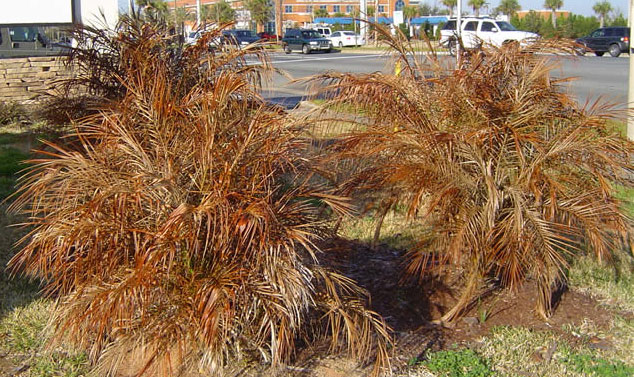Turning Brown: How To Help Your Palm Recover From The Cold
February 28, 2010
Many varieties of palms across the North Escambia area are brown and sometimes even dead in appearance following our extremely cold weather. Drs. Monica Elliott and Tim Broschat from the University of Florida provide the following tips on how to cope with damaged palms.
Patience is essential with cold-damaged palms! If the palm leaf has any green tissue remaining, the leaf should not be removed until later in the year. Leaving damaged leaves on the palm during the remainder of the winter may actually help the palm survive future cold events. Once the palm has produced substantial new growth (2 to 3 new leaves), damaged leaf tissue can then be removed.
All new leaves of a palm develop from the apical meristem or bud located in the crown of the plant. It is the bud that really needs to be protected. Leaf bases naturally provide insulating protection to the bud. This natural protection is one reason not to over trim palms at any time of the year.
As warmer weather returns, primary or secondary plant pathogens often attack stressed plants through the cold damaged tissue. Copper fungicides are recommended as an attempt (not a guarantee) to protect the bud and developing leaves from diseases that may attack damaged leaf tissue. There is no research to confirm if this is effective or not. The recommendation is based on what has been observed regarding cold damage to palms and knowledge of fungicides. In most situations, it is the base of the spear leaf not yet emerged from the whorl of leaf bases that is damaged first, leading to a spear rot, which may then lead to a bud rot. Thus, the goal of a copper fungicide is to prevent this spear rot from developing into a bud rot that kills the bud, and thus the palm.
Copper fungicides are recommended over all other group of fungicides because they have broad activity against both bacteria and fungi. No other fungicides have this broad spectrum of activity. You must have complete coverage of the target tissue to be effective – in this case, the base of the spear leaf and the bud. This is more difficult to accomplish in some palm species than others, particularly those with crown shafts, because the leaf bases tightly surround the emerging spear leaf, preventing movement of a fungicide into the bud region.
If the spear leaf does rot and can be easily pulled from the bud, it should be removed immediately, followed by a copper fungicide spray or drench of the bud region, which is now exposed.
The normal recommendation is to apply the copper fungicides no more than twice because of the possibility of copper phytotoxicity. If it is believed that more chemical protection of the bud is needed after the copper fungicides have been applied, a broad-spectrum contact fungicide may be beneficial.
You will not know if the palm has survived the cold until new growth emerges, which may be 4 to 7 months later. Hence, the need for patience! The new growth may be severely malformed or damaged, but the emergence of any living leaf tissue is a sign the palm is alive. Subsequence leaves will gradually improve in quality, but it may take as long as a year before normal leaves emerge.
Comments
3 Responses to “Turning Brown: How To Help Your Palm Recover From The Cold”




Thanks
Good information.
Thanks for this. I was wondering about mine.